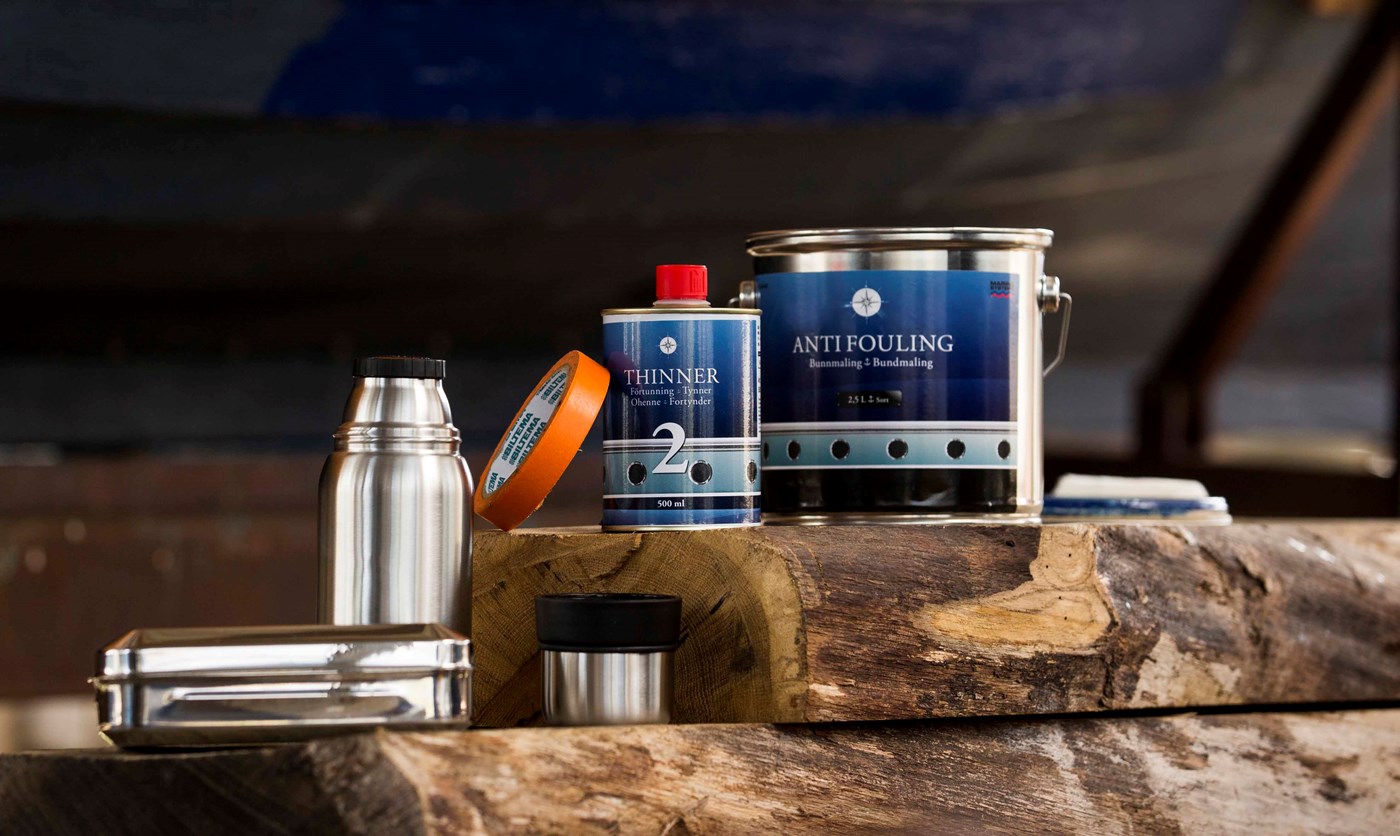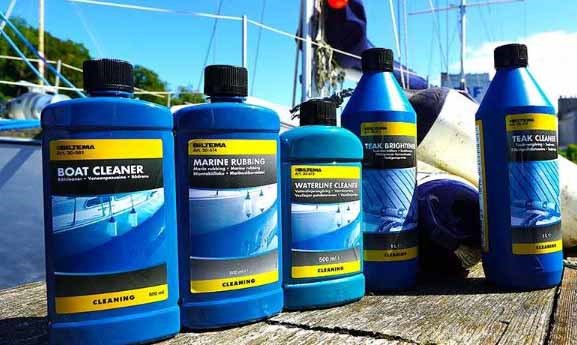Guide: Repairing a fibreglass boat
Published 2024.08.16
What is fibreglass?
Fibreglass consists of glass fibre and hardened plastic, and is therefore called a composite material. It is made by embedding fine glass fibre threads in a polymer matrix, typically consisting of polyester or epoxy. This fusion of materials results in a product that is both strong and lightweight. The strength and lightweight nature of fibreglass make it an ideal material for use in the hulls of boats. But it’s not just its physical characteristics that make it attractive.

Fibreglass is also recognised for its superior resistance to rot and weathering. This makes it a robust material that is more resistant than wood to the harsh water and weather conditions to which boats are often subjected. Fibreglass can easily withstand small scratches, but if you do experience major damage, you can repair the damage yourself relatively easily.
When should you repair your fibreglass?
Repairing fibreglass may be necessary when wear and damage occurs to the hull, which can have major consequences for the boat. If you experience one or more of the situations below, then you should consider repairing your fibreglass.
- Fibre breaks or cracks: If your boat has visible breaks or cracks in the fibreglass, it may indicate structural problems. Even if they are small, they should be repaired to avoid them worsening over time.
- Dented or deformed areas: If you notice dents or deformed areas on the hull, it could be a sign of problems in the boat’s structure or water ingress. These areas need to be inspected and repaired.
- Gelcoat damage: Gelcoat is the outer layer of the fibreglass surface that gives the boat its smooth finish. Damage such as cracks, peeling, or colour changes in the gelcoat may require repair to prevent further corrosion or weathering. Also keep an eye out for osmosis, which looks like blue blisters under the gelcoat. These can indicate that your boat is under attack.
- Water ingress: Water ingress can cause serious problems in the boat’s core structure, such as rot, mould and fungus. Repairs are needed to stop water ingress and prevent further damage.
- Collision damage: Damage to the fibreglass can also occur if you collide with an object, another vessel or run aground. It is important to inspect and repair any damage to maintain the boat’s safety and performance.
Minor repairs can sometimes be done as a DIY project, while larger or more complex repairs may require professional assistance from a boat repair company.
Repairing with polyester or epoxy
When repairing damage, you will need three ingredients: glass fiber, hardener, and polyester or epoxy. Polyester is an old material, and it has previously been used for all boats. Polyester is still most commonly used because it is cheap.
However, fibreglass repair, especially for damage such as a hole in the hull, is best and easiest to do with epoxy-products. This material is 3-4 times stronger than standard polyester, making it a good and durable choice. Epoxy also contains no solvents and is completely odourless. These elements make the material more comfortable to work with compared to polyester.
Step-by-step guide: How to repair your boat’s fibreglass
No matter if you need to repair a crack or a hole, the method is the same. It is relatively simple if you follow the manufacturer’s instructions for mixing hardener and polyester or epoxy. If you have the courage to do so, follow our step-by-step guide and get it fixed in a few hours, depending on the extent of the damage. Also, make sure you have all the equipment and materials you need before starting.
For the repair, you will need:
- Glass fibre
- Hardener
- Polyester or epoxy
- Hobby knife
- Paintbrush
- Aluminium roll
Step 1: Assess the extent of the damage
Before you start the repair, it is important that you assess the extent of the damage. Start by inspecting the damaged area so that you can identify any potential cracks, holes, or other damage. Consider the damage - is it a superficial scratch, or is it a deeper hole? This will help you determine what materials and tools you need, as well as how long the repair is likely to take. Keep in mind that major damage may require professional assistance.
Step 2: Sanding irregularities and damaged materials
The next step in the process is to sand the cosmetic or structural damage to remove all the damaged or loose material and irregularities before starting the repair. Doing this will ensure the most durable and smooth look when the new fibreglass is applied. For sanding, you can use sandpaper.

Step 3: Clean the affected area
It is important that you clean the damaged area of dust, dirt and grease so that you can apply your fibreglass more easily afterwards.

Step 4: Cut the fibreglass
Cut the fibreglass mats with a hobby knife in sizes corresponding to the damaged area. Cut several layers in different sizes so you can fill the hole with the smallest ones first and slowly build up with the big ones. How much fibreglass you need to cut depends on how deep or extensive the damage is.
Step 5: Mix hardener with polyester or epoxy
Once you have prepared the damaged area and cut the correct amounts of fibreglass, you can start mixing your hardener with polyester or epoxy. Don’t do it too early in the process, as there is a risk it will dry before you are ready.

If you ensure the correct mixing ratio, and at the same time mix the materials at a room temperature of 15-20 °C, you have about 30 minutes to apply the mixture before it dries. If the temperature is too high, you risk losing up to 50% of the hardening effect, and if the temperature is too low, the hardening may be too weak.
Step 6: Apply your mixture
Now it’s time to apply polyester or epoxy with a paintbrush for the paint job. These materials act as a binder and strengthen the repair by ensuring that the fibreglass mats adhere properly.
Use a paintbrush to apply a generous layer of the mixture to the damaged area, making sure to cover the entire area where you want to lay the fibreglass mats. This process ensures that the fibreglass will bond to the surface of the boat, creating a solid and durable mend.
Step 7: Apply the fibreglass
As soon as polyester or epoxy is spread on the area, you can apply the fibreglass mats. Make sure to smooth them out so that they lie as evenly as possible. Then take the paintbrush with polyester or epoxy and dub the area so that the fibreglass has good contact with the surface and there is no air under the mats. Once you have wet the fibres enough, they will turn completely transparent – and it will therefore be easy to see if you need to apply more. Repeat this until you have applied the desired number of layers, and then leave it to harden.
Take good care of your boat and reduce the risk of cracks and damage
You can never fully protect your boat against cracks and damage. But, as a boat owner, you can take many precautions that reduce the risk of cracks and damage in the hull. If you take good care of your boat, it will not only have a longer service life, but you will also save time and money in the long run. Here are our top five tips on how to take good care of your boat:
- Regular inspection: It is important that you inspect your boat frequently for cracks, dents, and other damage. If you do this after each boat trip, you can detect the scratches in time and repair them.
- Cleaning and waxing: Buy good boat care products, and make sure to regularly wash and wax your boat to protect against stubborn dirt, salt water, algae, and other harmful elements. These can break down the hull materials. Also read some good tips for polishing your boat.
- Proper storage: If you store your boat correctly – both in winter and when not in use – you can ensure a longer service life. Heat the boat on a boat stand so that it is not in contact with the ground, and protect it with a good quality boat cover. This is also called boat lay-up, and you can get a lot of good advice on this in our Boat Lay-up Guide.
- Protective hull treatment: Applying antifouling paint gives the boat a protective layer that helps prevent the growth of algae and subaquatic organisms. Make sure your boat is protected all year round.
- Correct anchoring: A boat anchor is both large and heavy, and it can cause major damage if not handled correctly. Avoid sudden jerks or bumps that could cause damage to the hull.
If you keep these tips in mind, you will find that you will need to repair your fibreglass much less frequently. And then your boating hobby will be both more fun and more manageable.
Get more good advice for boat care
At Biltema, we are dedicated to guiding you as a boat owner – both in terms of repairs and care. Of course, the boat’s hull plays a crucial role in the its ability to stay afloat, but the rest of the boat also requires attention to remain functional.
That’s why we have prepared a Good Boat Care Guide, so that the bottom, top, exterior, and interior can stay in top condition for your boating trips. Here you can read about washing your boat, cleaning, protection, repairs, polishing and much more.



